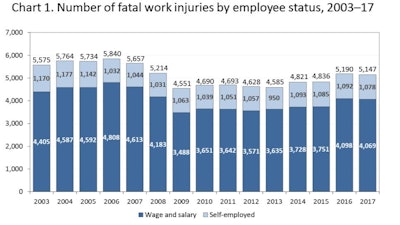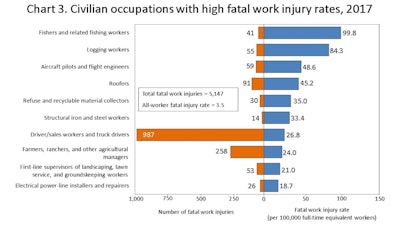
As thousands enter the workforce, there were 43 fewer workplace fatalities in 2017 than the previous year, according to the Bureau of Labor Statistics’ National Census of Fatal Occupational Injuries in 2017 (CFOI) report released on December 18, 2018. The fatal injury rate also decreased from 3.6% in 2016 to 3.5% in 2017.
There were a total of 5,147 fatal work injuries recorded in the United States in 2017, down slightly from the 5,190 fatal injuries reported in 2016, the U.S. Bureau of Labor Statistics reported (see chart 1). The fatal injury rate decreased to 3.5 per 100,000 full-time equivalent (FTE) workers from 3.6 in 2016.
“While [the report] shows a decline in the number of workplace fatalities, the loss of even one worker is too many,” said Loren Sweatt, Acting Assistant Secretary for the Occupational Safety and Health Administration (OSHA). “Through comprehensive enforcement and compliance assistance that includes educating job creators about their responsibilities under the law, and providing robust education opportunities to workers, OSHA is committed to ensuring the health and safety of the American workforce.”
Type of Incident
Fatal falls were at their highest level in the 26-year history of the Census of Fatal Occupational Injuries (CFOI), accounting for 887 (17%) worker deaths. Transportation incidents remained the most frequent fatal event in 2017 with 2,077 (40%) occupational fatalities. Violence and other injuries by persons or animals decreased 7% in 2017 with homicides and suicides decreasing by 8% and 5%, respectively (see chart 2). 
In addition to the decline in overall fatalities, crane-related workplace fatalities, and fatal occupational injuries in the private manufacturing industry and wholesale trade industries reached their lowest points since the CFOI started in 2003.
The number of unintentional overdoses due to the nonmedical use of drugs or alcohol while at work increased by 25% – the fifth consecutive year overdose deaths rose by at least 25%.
“The scourge of opioid addiction unfortunately continues to take its toll on workers across the country,” said Sweatt, “demonstrating the importance of this Administration’s efforts to tackle this crisis.”
Construction Labor Shortage May Be Contributing to Opioid Abuse
Contractors Optimistic with Strong Backlog, Fear Growing Safety Risks
In addition to the decline in overall fatalities, crane-related workplace fatalities, and fatal occupational injuries in the private manufacturing industry and wholesale trade industries reached their lowest points since the CFOI started in 2003.
- Contact with objects and equipment incidents were down 9% (695 in 2017 from 761 in 2016), with caught in running equipment or machinery deaths down 26% (76 in 2017 from 103 in 2016).
- Fatal occupational injuries involving confined spaces rose 15% to 166 in 2017 from 144 in 2016.
- Crane-related workplace fatalities fell to their lowest level ever recorded in CFOI, 33 deaths in 2017.
Occupation
The transportation and material moving occupational group and the construction and extraction occupational group accounted for 47% of worker deaths in 2017. Within the occupational subgroup driver/sales workers and truck drivers, heavy and tractor-trailer truck drivers had the largest number of fatal occupational injuries with 840. This represented the highest value for heavy and tractor-trailer truck drivers since the occupational series began in 2003. Fishers and related fishing workers and logging workers had the highest published rates of fatal injury in 2017 (see chart 3).
- Grounds maintenance workers (including first-line supervisors) incurred 244 fatalities in 2017. This was a small decrease from the 2016 figure (247) but was still the second-highest total since 2003. A total of 36 deaths were due to falls from trees, and another 35 were due to being struck by a falling tree or branch.
- There were 258 fatalities among farmers, ranchers, and other agricultural managers in 2017. Approximately 63% of these farmers were age 65 and over (162) with 48 being age 80 or over. Of the 258 deaths, 103 involved a farm tractor.
- Police and sheriff’s patrol officers incurred 95 fatal occupational injuries in 2017, fewer than the 108 fatalities in 2016.
Other key findings of the 2017 Census of Fatal Occupational Injuries:
- Fifteen percent of the fatally injured workers in 2017 were age 65 or over – a series high. In 1992, the first year CFOI published national data, that figure was 8%. These workers also had a higher fatality rate than other age groups in 2017.
- Fatalities incurred by non-Hispanic Black or African American workers and non-Hispanic Asian workers each decreased 10% from 2016 to 2017.
- Fatal occupational injuries in the private manufacturing industry and wholesale trade industry were the lowest since this series began in 2003.
- Workplace fatalities in the private mining, quarrying, and oil and gas extraction industry increased 26% to 112 in 2017 from a series low of 89 in 2016. Over 70% of these fatalities were incurred by workers in the oil and gas extraction industries.
- A total of 27 states had fewer fatal workplace injuries in 2017 than 2016, while 21 states and the District of Columbia had more; California and Maine had the same number as 2016. (See table 5.) A total of 192 metropolitan statistical areas (MSAs) had 5 or more fatal work injuries in 2017.
Find the full report at https://www.bls.gov/news.release/pdf/cfoi.pdf.
Employers who need assistance in meeting their safety obligations can take advantage of OSHA’s no-cost and confidential On-Site Consultation Program. OSHA Training Institute Education Centers (OTIs) also provide training workers, employers, and other safety professionals across the nation.



















